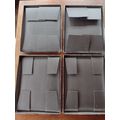Jedburgh, Scottish Borders - M&L multiview postcard c.1960s
- Condition : Used
- Dispatch : 2 Days
- Brand : None
- ID# : 206277012
- Quantity : 1 item
- Views : 135
- Location : United Kingdom

- Seller : justthebook (+1699)
- Barcode : None
- Start : Fri 31 Dec 2021 05:44:16 (EDT)
- Close : Run Until Sold
- Remain : Run Until Sold
Checks/Cheques
 for 1 item(s) edit
for 1 item(s) edit
Shipping Calculator
More Listings from This Seller view all
Seller's Description
- Postcard
- Picture / Image: Jedburgh [Borders formerly Roxboroughshire] : Abbey / Canongate / Queen Marys House / Canongate Bridge / Jedburgh / The Capon Tree / Market Place & High Street / Abbey & War Memorial / The Teviot from Monteviot
- Publisher: M & L National Series
- Postally used: yes
- Stamp: 3d purple Scottish regional
- Postmark(s): wavy line [date unclear]
- Sent to: Roffey, Horsham, Sussex
- Notes / condition:
Please ask if you need any other information and I will do the best I can to answer.
Image may be low res for illustrative purposes - if you need a higher definition image then please contact me and I may be able to send one. No cards have been trimmed (unless stated).
------------------------------------------------
Postage & Packing:
Postage and packing charge should be showing for your location (contact if not sure).
No additional charges for more than one postcard. You can buy as many postcards from me as you like and you will just pay the fee above once. Please wait for combined invoice. (If buying postcards with other things such as books, please contact or wait for invoice before paying).
Payment Methods:
UK and all other locations - PayPal or other methods listed above.
NOTE: All postcards are sent in brand new stiffened envelopes which I have bought for the task. These are specially made to protect postcards and you may be able to re-use them.
I will give a full refund if you are not fully satisfied with the postcard.
----------------------------------------------
Text from the free encyclopedia WIKIPEDIA may appear below to give a little background information (internal links may not work) :
*************
Jedburgh (/ˈdʒɛdbərə/; Scottish Gaelic: Deadard; Scots: Jeddart or Jethart)[2] is a town and former royal burgh in the Scottish Borders and the traditional county town of the historic county of Roxburghshire,[3] the name of which was randomly chosen for Operation Jedburgh in support of the D-Day invasion.
Jedburgh lies on the Jed Water, a tributary of the River Teviot. It is 10 miles (16 km) from the border with England, and is dominated by the substantial ruins of Jedburgh Abbey. Other notable buildings in the town include Queen Mary's House, Jedburgh Castle Jail, now a museum, and the Jedburgh Library. Other places nearby are Ancrum, Bairnkine, Bonjedward, Camptown, Crailing, Edgerston, Ferniehirst Castle, Nisbet and Oxnam.
Mercat Cross from Castlegate
History
Jedburgh began as Jedworð, the "worth" or enclosed settlement on the Jed. Later the more familiar word "burgh" was substituted for this, though the original name survives as Jeddart/Jethart.[4]
Bishop Ecgred of Lindisfarne founded a church at Jedburgh in the 9th century, and King David I of Scotland made it a priory between 1118 and 1138, housing Augustinian monks from Beauvais in France. The abbey was founded in 1147, but border wars with England in the 16th century left it a ruin.[5]
The deeply religious Scottish king Malcolm IV died at Jedburgh in 1165, aged 24. His death is thought to have been caused by Paget's disease of bone.[6]
David I built a castle at Jedburgh, and in 1174 it was one of five fortresses ceded to England. It was an occasional royal residence for the Scots. It was demolished in 1409.[7]
Jedburgh Abbey
Panorama of Jedburgh Castle
In 1258, Jedburgh was a focus of royal attention, with negotiations between Scotland's Alexander III and England's Henry III over the succession to the Scottish throne, leaving the Comyn faction dominant. Alexander III was married to Yolande in the abbey in 1285.[8]
Its proximity to England made it subject to raids and skirmishes by both Scottish and English forces but its strategic position also brought the town valuable trade. At various times and at various locations the town supported a horse market, a cattle market, a corn market and a butcher market. Farm workers and servants also attended hiring fairs seeking employment.[9]
Mary, Queen of Scots, stayed at a certain house in the town in 1566 and that house is now a museum – Mary Queen of Scots House.[10]
Listing Information
| Listing Type | Gallery Listing |
| Listing ID# | 206277012 |
| Start Time | Fri 31 Dec 2021 05:44:16 (EDT) |
| Close Time | Run Until Sold |
| Starting Bid | Fixed Price (no bidding) |
| Item Condition | Used |
| Bids | 0 |
| Views | 135 |
| Dispatch Time | 2 Days |
| Quantity | 1 |
| Location | United Kingdom |
| Auto Extend | No |



















